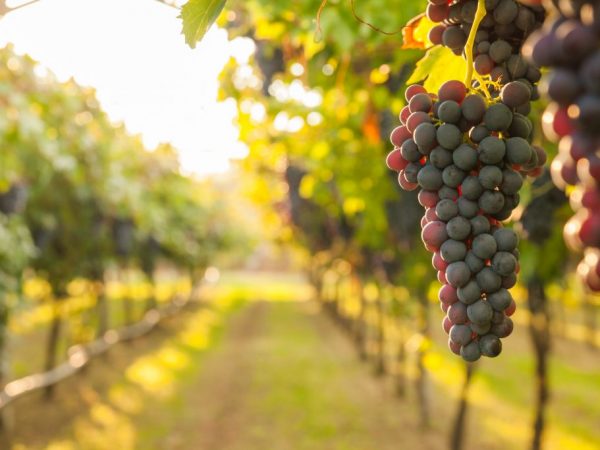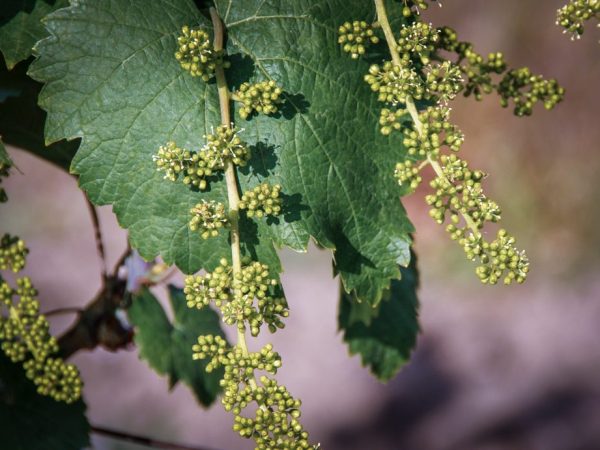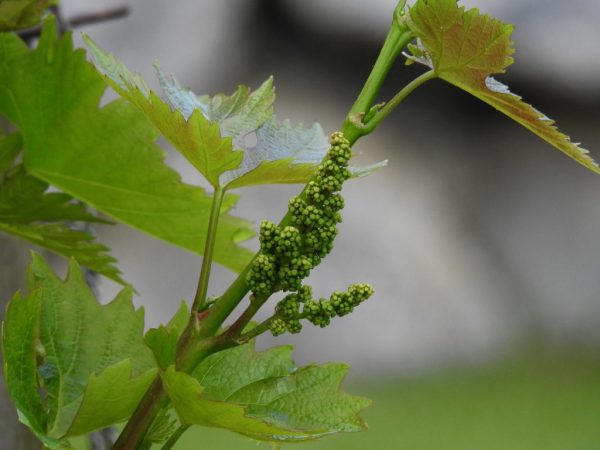What is a grapevine
The vine is a liana-like plant with woody stems. Many people call grapes a tree, but this is not true. Rather, it is a bush with flexible branches that cling to a support. The vine has a special structure and development cycle. In order for it to bear fruit, it must be properly cared for.
- What is a grapevine
- Root system
- Aerial part of the plant
- Stem or barrel
- Sleeves and annual shoots
- Leaves and tendrils
- Inflorescences and fruits
- Stages of vine development
- The beginning of the movement of juices
- Growth phase
- Bloom
- Growth and ripening of berries
- Leaf fall and dormancy
- How to speed up the growth of a vine
- Diseases and pests of the vine

Vine
What is a grapevine
The grape is a plant from the Dicotyledonous class, of the order Grape, of the Grape family. The vine is called the shoots, and sometimes the whole bush, which bears tasty fruits. The species grows on different continents. According to the place of origin, the following groups are distinguished:
- European-Asian;
- North American;
- East Asian.
For thousands of years, people have been growing the vine, and it has firmly entered the culture of many nations. The image of branches and bunches can be seen on ancient Greek vases, the walls of buildings in ancient Rome, in the Egyptian pyramids. She became an important symbol in Judaism and Christianity.
Today, hundreds of table and technical varieties have been bred. Grapes are widely used: wine, juices, and jams are made from it. Berries are eaten fresh, dried, candied. The benefits of sweet fruits rich in vitamins are enormous, they even have medicinal properties. Some varieties are used for decoration, weaving.
Grapes are grown from seeds or cuttings. The vine consists of the following parts:
- root;
- trunk or trunk;
- sleeves with annual shoots;
- temporary organs: leaves, flowers and berries.
Root system
The root sprouts either from grape seeds or from the buds of the lower part of the petiole. How lush and productive the vine grows depends on its development. This is the reason why it is so important to root the cutting well or let the seed germinate well.
The root system is located at 3 levels. The top plays a minor role in the transfer of nutrients to the branches. The middle one is the lateral roots, their role is also insignificant. The main load for the absorption of nutrients is borne by deep roots.
Old, thick roots covered with bark transfer nutrients to the aerial part of the plant. The young play a connecting role between the old and the roots. Small roots have a lot of villi, with the help of which minerals and organic matter are taken from the soil. In late autumn, they die off, and in the spring they grow back.
The spine consists of 3 parts:
- tip with yellow cap;
- growth zones;
- absorption zones with many small villi.
The development and size of the root system depends on the type of soil, the content of nutrients in it. It is desirable to achieve that the lower part at the root of the vine is the most branched, has 5-6 orders of magnitude.
Aerial part of the plant

The aboveground part consists of a trunk and shoots
The aboveground part of the vine includes a stem (trunk) and sleeves with annual shoots.In summer, leaves, tendrils, inflorescences and fruits appear on annual shoots that have matured.
Stem or barrel
A young vine of the first year does not yet have a lignified trunk. If it sprouts from a seed, a single stem appears above the surface. 2-3 stems grow from the cuttings, depending on the number of buds left on the surface during planting. At the beginning, the branching at the stem is monopodial, the structure of the vine is five-pointed, and the leaves grow in a spiral. Then the structure changes.
The formed young trunk consists of nodes and internodes. Each node has a septum or diaphragm. There are 4 sides to it:
- abdominal;
- dorsal;
- grooved;
- flat.
Fibers, pith, bark and wood are better developed on the ventral side, therefore it is slightly convex. During the period of intensive growth, the dorsal side stretches faster, the vine bends towards the abdominal side. When growth ends, it becomes even. The lateral sides are wider in area than the ventral and dorsal. The structure of the stem is clearly visible in the section.
The lower part of the trunk is called the head, and it is located at the border with the root. There are dormant buds in the head area. Normally, they do not develop, but they are able to give new shoots when the vines freeze out or too intensively.
Sleeves and annual shoots
To grow the vine, it is constantly pruned. In the process of pruning, sleeves are formed, perennial lignified branches. In a normal bush of grapes, 6-8 such branches are formed. Fruit arrows and replacement knots are located on them. If the vine has produced more sleeves, they are completely cut off.
Arrows or annual shoots develop from hibernating buds. They are covered with thin green bark without any signs of lignification. It is on annual shoots that leaves, flowers and fruits grow. Thick, annual branches that do not bear fruit are called “fattening shoots”. They take the juices from the plant and reduce the yield. Leaving such branches is harmful, they get rid of them during summer pruning.
Leaves and tendrils
The leaves are oppositely arranged, consisting of a petiole, stipule and a plate. The stipule falls off quickly. The petiole is thick, through which nutrients enter the leaf. The leaf plate is wide and smooth. The color of the leaf is green, it is penetrated by veins of several orders.
There are main and stepson buds in the leaf axils. The latter give rise to thin stems - stepchildren. They are not as strong as annual shoots. Their leaves are small, light green. On stepchildren, fruits sometimes ripen, but the bunches are weak, often fall off. Stepsons recommend deleting. They are left only in cases where a meager harvest is expected.
Thin antennae grow from internodes, in structure they resemble branches. They are located opposite to the leaves. They constantly rotate, complete a circle in an hour. With the help of tendrils, the vine twists and clings to the support. These thin shoots twist around a net, sticks, cling to an arch, a railing or other fastening, support thick branches.
Inflorescences and fruits

The grapes are pollinated by the wind
The vine has a green hue. It looks inconspicuous, is located on an uviform inflorescence, which is laid and formed in wintering buds. In another way, the inflorescence is called "panicle". One panicle holds from 200 to 1500 flowers. Antennae often develop at its base.
The corolla of the flower looks like a small cap. It disappears at the beginning of flowering. In modern varieties and hybrids, flowers are unisexual (male or female) and bisexual. Males have well-developed stamens with an atrophied pistil. Female - large pistil without stamens. In bisexual, reproductive organs are equally developed. The grapes are pollinated by the wind. For successful fertilization, the air temperature should be at least 15 ° С, and the optimal temperature should be 25 ° С-30 ° С.
The berries are small, round and green at first. Then they stretch and change color.Depending on the variety, they are yellow, pink, blue or purple. The number of bunches on a branch depends on the season, the age of the vine, and the variety.
Stages of vine development
Growing a vine requires an understanding of the stages of its development. The correct preparation of grapes for spring or wintering, care during the fruiting period depends on this. There are 7 stages in total:
- the beginning of the movement of juices, or crying;
- growth phase;
- bloom;
- the growth of bunches;
- ripening of berries;
- leaf fall;
- rest period.
The beginning of the movement of juices
This phase begins in spring when the soil temperature in the root area rises to 8 ° C-10 ° C. The juice of the grape vine is released so intensely that it drips like tears, it “cries”. This does not harm the plant, but the branches should be pruned before the juices begin to move. If the weather is dry, too much tearing will cause reduced yields.
The duration of the phase is 10-20 days.
Growth phase
The vine begins to grow after the weeping is over, when the outside temperature rises to 10 ° C-15 ° C and above. At this time, proper care is of great importance. The size of young shoots per day increases by 6-10 cm. When the length becomes 30-35 cm, the branches are tied up.
When the tree grows intensively, it must be fed to accelerate the ripening of the shoots. Mineral and organic fertilizers are applied once or twice.
The growth period is a favorable time for treating the vines from parasites and diseases. By the time the berries are formed and ripen, the chemicals will have time to decompose and not penetrate the fruits.
Bloom

Weak inflorescences must be removed
The vine blooms for 15-20 days, in late May or early June. Root feeding is carried out 2-3 weeks before it starts. When the grapes are in bloom, the number of inflorescences is monitored. If there are too many of them, the weak ones are removed. Weather conditions can interfere with fertilization: too low air temperature, rain, hail, drought. In such cases, artificial pollination is carried out.
Growth and ripening of berries
During the growing period, no special action should be taken in relation to the vine. The main thing is to monitor the condition of growing berries, to identify diseases and pests in time. When the bunches are full and ripe, shoots are minted. The longest ones are shortened by 15-20%, stepsons are removed. This procedure improves the quality of the berries, makes them larger and sweeter. The duration of the growth and ripening phase of berries depends on the variety, weather conditions.
Leaf fall and dormancy
The leaves on the bushes begin to turn yellow and fall off after harvest, from about mid-September to late October. At this time, the growth process and the movement of juices in the vine slows down, and eventually dies down completely. When the bush drops all the foliage, and the temperature approaches 0 ° C, pruning is carried out. Unripe vine, fruit branches and fattening shoots are removed. Only sleeves with replacement knots are left. During this period, seedlings are harvested.
The dormant or wintering period begins in late autumn and lasts until early spring. Dates vary, depending on the region.
In temperate climates, the vine is covered for the winter. It is advised to dig it in or cover it with a film. This protects the buds from freezing, ensures a good harvest for the next year.
How to speed up the growth of a vine
For a vine to develop properly, it must be grown under normal conditions. The plant is considered whimsical, but caring for it is simple. To accelerate growth, provide:
- Normal soil. Grapes do not tolerate salt marshes. When planting on clay soil, good drainage is placed on the bottom of the pit. Peat soil is mixed with sand, compost is added to the sandy soil. Lime is added to the acidic soil.
- Humidity. Grapes do not like areas with a high groundwater table. It needs watering, but you can't abuse water either. A good overflow remedy is to plant the bush in a hole with normal drainage.
- Temperature.The ideal temperature can really be arranged only for seeds and cuttings during rooting and germination. For this, a young plant is kept at home or a small greenhouse is arranged for it. For the winter, the vine is sheltered in cold regions, otherwise it freezes. To protect the root system, the vine is planted in deep trenches. If it is too hot outside, the bush slows down its growth and needs more intensive watering.
- Lighting. In order for the grapes to grow normally, the berries ripen well, they are planted in a lighted area, protected from the wind. The south, south-east or south-west side of the building, the side of a hill, will do.
When growing grape vines from seeds, stratification must be carried out. They are kept in wet sand at a low temperature; for quick rooting, cuttings are treated with stimulants.
Diseases and pests of the vine
Vines slow growth and reduce yields when they are sick or infested with pests. To help the plant in time, they look at the symptoms of diseases. Some of them:
- Cancer. It is a bacterial disease that occurs after pruning with poorly machined tools. It is manifested by swelling of the bark, white blistery growths.
- Anthracosis. Fungus causes disease. Small brown spots appear on the branches, leaves and fruits, which quickly merge. The berry cracks or falls off.
- Mildew or downy mildew. Occurs in high humidity, caused by a fungus. An oily light green bloom appears on fruits and leaves. Most often, the disease occurs in early summer, when the berries begin to set.
- Rubella. Red spots appear on the leaves with a yellow or light green rim. Over time, the entire leaf turns red and falls off. Dark grape varieties are more likely to suffer.
- Oidium or powdery mildew. Leaves and berries are first covered with a thin cobweb, then it turns into a white bloom, resembling flour or ash. The disease is caused by a fungus that is resistant to many fungicides and is therefore difficult to treat.
- Chlorosis. Pathology is caused by improper cultivation, mistakes in care. The leaves turn yellow and fall off, the vine grows poorly.
- Cercoporosis. With this fungal pathology, yellow spots with a red rim appear on the leaves. Green bloom or mold appears on the bottom of the leaf.
- Black rot. First, brown spots and thickening along the veins appear on the leaves. Then the berries are affected: they rot and shrivel, the fruiting bodies of the mushrooms become visible on the surface.
- Among pests, wasps and aphids most often attack grapes.
For the treatment of fungal diseases, fungicides, Bordeaux liquid, copper and iron vitriol are used. They fight pests with insecticides, arrange traps for wasps. One of the most effective methods of protection is the development of varieties that are resistant to pathologies and parasites.


